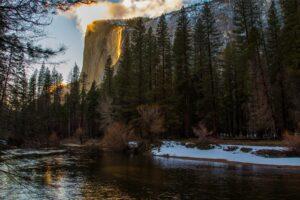Hiking
Tours and Outfitters
Wilderness Center. This facility provides free wilderness permits, which are required for overnight camping (advance reservations are available for $5 per person plus $5 per reservation and are highly recommended for popular trailheads in summer and on weekends). The staff here also provides maps and advice to hikers heading into the backcountry. If you don't have your own bear-resistant canisters, which are required, you can buy or rent them here. Between Ansel Adams Gallery and post office, Yosemite Village, California, 95389. 209/372–0308. May–Oct., daily 8–5; permits at Valley Visitor's Center Nov.–Apr..
Yosemite Mountaineering School and Guide Service. From April to November, you can rent gear, hire a guide, or join a two-hour to full-day trek with Yosemite Mountaineering School. They also lead backpacking and overnight excursions. Reservations are recommended. In winter, cross-country ski programs are available at Badger Pass Ski Area. Yosemite Mountain Shop, Curry Village, Yosemite National Park, California, 95389. 209/372–8344; yosemitemountaineering.com.
Easy
Cook's Meadow Loop. Take this 1-mile, wheelchair-accessible, looped path around Cook's Meadow to see and learn the basics about Yosemite Valley's past, present, and future. A trail guide (available at a kiosk just outside the entrance) explains how to tell oaks, cedars, and pines apart; how fires help keep the forest floor healthy; and how pollution poses significant challenges to the park's inhabitants. Easy. Yosemite National Park, California, 95389.
Yosemite Falls Trail. Yosemite Falls is the highest waterfall in North America. The upper fall (1,430 feet), the middle cascades (675 feet), and the lower fall (320 feet) combine for a total of 2,425 feet, and when viewed from the valley appear as a single waterfall. The ¼-mile trail leads from the parking lot to the base of the falls. Upper Yosemite Fall Trail, a strenuous 7.2-mile round-trip climb rising 2,700 feet, takes you above the top of the falls. Lower trail: Easy. Upper trail: Difficult. Yosemite National Park, California, 95389.
Moderate
Mist Trail. Except for Lower Yosemite Fall, more visitors take this trail (or portions of it) than any other in the park. The trek up to and back from Vernal Fall is 3 miles. Add another 4 miles total by continuing up to 594-foot Nevada Fall; the trail becomes quite steep and slippery in its final stages. The elevation gain to Vernal Fall is 1,000 feet, and to Nevada Fall an additional 1,000 feet. The Merced River tumbles down both falls on its way to a tranquil flow through the valley. Moderate. Yosemite National Park, California, 95389.
Panorama Trail. Few hikes come with the visual punch that this 8½-mile trail provides. It starts from Glacier Point and descends to Yosemite Valley. The star attraction is Half Dome, visible from many intriguing angles, but you also see three waterfalls up close and walk through a manzanita grove. Moderate. Yosemite National Park, California, 95389.
Difficult
Chilnualna Falls Trail. This Wawona-area trail runs 4 miles one-way to the top of the falls, then leads into the backcountry, connecting with other trails. This is one of the park's most inspiring and secluded—albeit strenuous—trails. Past the tumbling cascade, and up through forests, you'll emerge before a panorama at the top. Difficult. Wawona, California, 95389.
Four-Mile Trail. If you decide to hike up Four-Mile Trail and back down again, allow about six hours for the challenging, 9½-mile round-trip. (The original 4-mile-long trail, Yosemite's first, has been lengthened to make it less steep.) The trailhead is on Southside Drive near Sentinel Beach, and the elevation change is 3,220 feet. For a considerably less strenuous experience, you can take a morning tour bus up to Glacier Point and enjoy a one-way downhill hike. Difficult. Yosemite National Park, California, 95389.
John Muir Trail to Half Dome. Ardent and courageous trekkers continue on from Nevada Fall to the top of Half Dome. Some hikers attempt this entire 10- to 12-hour, 16¾-mile round-trip trek in one day; if you're planning to do this, remember that the 4,800-foot elevation gain and the 8,842-foot altitude will cause shortness of breath. Another option is to hike to a campground in Little Yosemite Valley near the top of Nevada Fall the first day, then climb to the top of Half Dome and hike out the next day. Get your wilderness permit (required for a one-day hike to Half Dome, too) at least a month in advance. Be sure to wear hiking boots and bring gloves. The last pitch up the back of Half Dome is very steep—the only way to climb this sheer rock face is to pull yourself up using the steel cable handrails, which are in place only from late spring to early fall. Those who brave the ascent will be rewarded with an unbeatable view of Yosemite Valley below and the high country beyond. Only 300 hikers per day are allowed atop Half Dome, and they all must have permits, which are distributed by lottery, one in the spring before the season starts and another two days before the climb. Contact www.recreation.gov for details. Difficult. Yosemite National Park, California, 95389. www.nps.gov/yose/planyourvisit/halfdome.htm.





